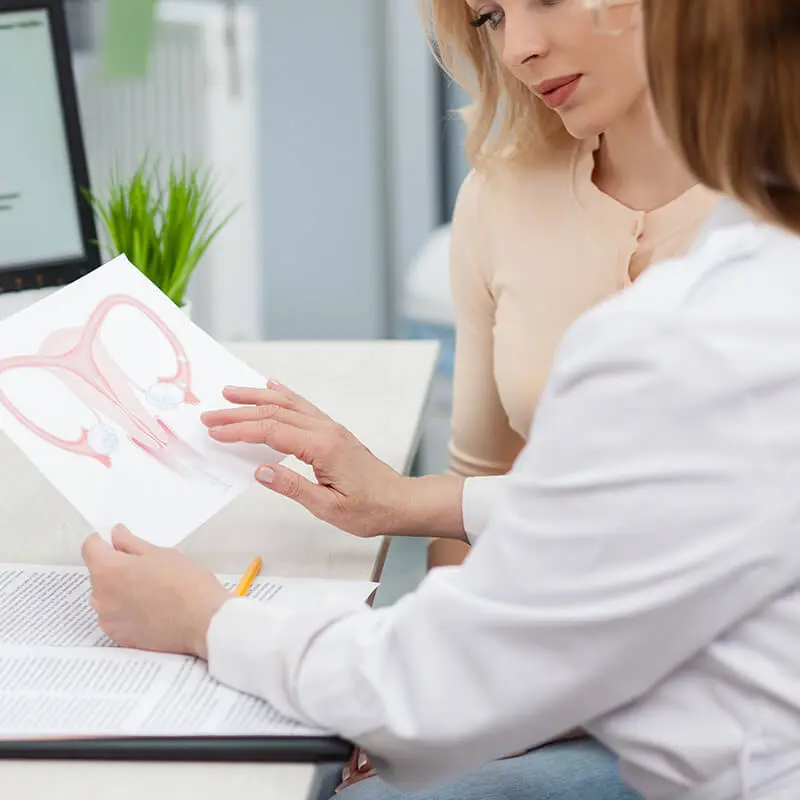
Two of the most common fertility treatments are:
- Intrauterine insemination (IUI). Healthy sperm is collected, washed and inserted directly into your uterus when you’re ovulating.
- In vitro fertilization (IVF). Eggs are taken from your ovaries and fertilized by sperm in a lab, where they develop into embryos.
What Are IVF Cycle Steps?

- Medications given to stimulate egg(s)
- Egg retrieval from the ovaries
- Insemination of eggs with sperm
- Culture of fertilized eggs (embryos)
- Embryo transfer to the uterus
- Hormone support of the uterine lining
Other potential procedures may be needed to increase fertilization chances such as:
- Intracytoplasmic Sperm Injection (ICSI)
- Assisted Hatching of Embryos
- Embryo Cryopreservation (freezing)
Optimal In Vitro Fertilization (IVF) results in multiple eggs. In order to increase your chances for this outcome, you may be treated with hormone therapy medications or injections to help your ovaries produce eggs. You will be tested to determine your levels and is outlined below.
Getting Started Prior to IUI Requires Testing
At Inovi we want to provide you and your partner with answers quickly but also complete a thorough evaluation so your recommended fertility treatment options have the best chance for success. This typically includes hormone testing, semen testing and infectious disease screening to determine if you are experiencing conditions that may be causing irregular ovulation, interfering with ovulation, deterring fertilization or hazardous to your baby such as:
- High or low thyroid function
- Polycystic ovary syndrome
- Elevated prolactin levels
- Elevated testosterone levels
Once the testing is complete, you and your fertility specialist will discuss the results. If you are having trouble ovulating, have unexplained infertility or diagnosed with one of the conditions above, you may be a candidate for ovulation induction (OI).
What is Ovulation Induction?
According to the American College of Obstetricians and Gynecologists, “Ovulation induction (OI) is the use of drugs to help your ovaries release an egg.” Often women who are having difficulty getting pregnant may experience irregular menstrual cycles or do not ovulate at all. Ideally, other previously diagnosed conditions that could contribute have been ruled out or treated prior to OI.
During OI, stimulation of your ovaries is done with the use of medications such as Clomiphene Citrate (Clomid), Letrozole (Femara) or Gonadotropins (injectable medicines) and may also be combined with intrauterine insemination to increase the chances of a successful pregnancy.

Table of Medications Used in OI
How is Ovulation Induction (OI) Done?
During ovulation induction, you take oral or injectable medication to increase your chances of ovulating. When ovulation occurs, your ovary releases an egg in the fallopian tube to be fertilized by the sperm during planned intercourse or intrauterine insemination. When ovulation induction is used to increase the numbers of eggs developing (maturing) it is called superovulation.
What Drugs Are Used in Ovulation Induction?
Clomiphene Citrate (Clomid) or Letrozole (Femara) is a pill taken beginning on day 3 or 5 after a woman begins her cycle and is continued for 5 days. Gonadotropins (e.g. Gonal F, Follistim, Menopur) are injectable medications typically started on day 3 after a woman begins her cycle (cycle day 3) and are taken for 7-10 days.
How Does Clomid Work?
Clomid works to block estrogen receptors in the hypothalamus and pituitary glands. This action prevents estrogen from interacting with the pituitary gland. After this occurs, your body then naturally begins to increase the hormones called, LH, FSH and Estrogen which are important in the egg maturation and ovulation process. When Clomid is given to males, the hormone levels are monitored at regular intervals.
How Does Letrozole (Femara) Work?
Femara (generic name is Letrozole) is an oral medication that can be an effective fertility treatment for women with ovulation problems (anovulation), polycystic ovary syndrome (PCOS) or for those with unexplained infertility.
It works by blocking the enzyme aromatase in the ovary which prevents estradiol (estrogen) production. This action suppresses your estrogen levels and triggers your brain and pituitary gland to increase the output of FSH (follicle stimulation hormone) resulting in ovulation induction (OI).
In women who are ovulating, Letrozole can stimulate the development of multiple follicles and eggs to be released often known as controlled ovarian hyperstimulation. This improves your chance of pregnancy as compared to a natural menstrual cycle where only one egg is released.
When Letrozole is used in combination with intrauterine insemination (IUI) your chances of pregnancy may significantly improve. It also can be an effective medication alternative where clomid has not resulted in a pregnancy success or positive outcome.
In a 2014 NIH funded study, researchers found that women treated with letrozole as compared to clomophene were more likely to ovulate as well as increase their chances of having a live birth.
How Do Gonadotropins Work?
Gonadotropins are hormones naturally produced by the pituitary gland in both men and women. One is known as the follicle-stimulating hormone (FSH) and the other is luteinizing hormone (LH). In women, these stimulate the ovaries to release an egg (oocyte).
You may be prescribed Gonadotropin hormone treatment if the medications Clomid or Letrozole did not result in a pregnancy, or if you have a low egg count as determined by your AMH or antral follicle count (AFC). This is usually given early in the menstrual cycle by injection to stimulate your ovaries to make multiple follicles (cysts where the eggs develop and mature). Your doctor may prescribe these hormones in combination with other fertility medications such as clomiphene citrate (clomid).
Unlike Letrozole that stimulates your brain to make and release follicle-stimulating hormone (FSH), gonadotropins actually contain FSH (e.g. Gonal F, Follistim) or a combination of FSH and LH (e.g. Menopur, Repronex) which stimulate the ovary directly. Patients with PCOS should not undergo ovulation induction with injectable medications due to the high risk of getting 4 or more follicles and the possibility of triplet or higher order multiple pregnancy.
Potential side effects of Gonadotropin Hormone Therapy include but are not limited to:
Ovarian Hyperstimulation Syndrome (OHSS) – OHSS is characterized by enlarged ovaries and fluid accumulation in the abdomen after stimulation by gonadotropins and after ovulation occurs.
Multiple Gestation – When using injectable gonadotropins alone or with IUI, up to 30% of pregnancies are associated with multiple implantations (twins or more), which only occur in 1% to 2% of naturally occurring pregnancies.
Ectopic (Tubal) Pregnancy – While ectopic pregnancies occur in 1% to 2% of naturally occurring pregnancies, in gonadotropin cycles the rate is slightly increased.
Adnexal Torsion (Ovarian Twisting) – In less than 2% of gonadotropin cycles the stimulated ovary can twist on itself since the ovary is heavier from more follicles.
Local or Generalized Reactions – Hormone injections may cause local skin irritation.
Gonadotropins and Cancer – Although early studies suggested that the risk of ovarian or other cancers of the female genital tract might be increased when exposed to medications for ovulation induction, current studies have shown no increase in any cancers with the use of fertility medications.

What are Additional Fertility Treatments?

Assisted Reproductive Technology
According to the American Association of Reproductive Medicine, assisted reproductive procedures are defined as:
“All interventions that include the in vitro handling of both human oocytes and sperm or of embryos for the purpose of reproduction. This includes, but is not limited to, IVF and embryo transfer (ET), intracytoplasmic sperm injection (ICSI), embryo biopsy, preimplantation genetic testing PGT, assisted hatching, gamete intrafallopian transfer GIFT, zygote intrafallopian transfer, gamete and embryo cryopreservation, semen, oocyte and embryo donation, and gestational carrier cycles. Thus, ART does not, and ART-only registries do not, include assisted insemination using sperm from either a woman’s partner or a sperm donor”
ART procedures have helped many couples conceive and may be recommended after other treatments such as intrauterine insemination have been unsuccessful.
You and your doctor may decide that your best chance for pregnancy is through Assisted Reproductive Technology (ART) using one of these procedures. There are risks involved such as multifetal gestation, premature births, low birth weight and others.
Making the decision to undergo ART is highly personal and carries with it benefits and risks. We counsel all women concerning their medical procedures and provide them the opportunity to make informed choices for fertility treatment.
If you think you may be ready to take the first step toward meeting with Dr. Krotz and the Inovi team call us today at 713-401-9000.
Or maybe you need more information about one aspect of infertility. Please tell us how we can help!
